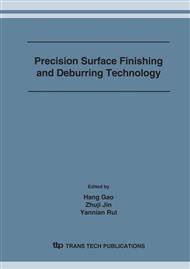p.189
p.195
p.201
p.211
p.217
p.223
p.229
p.233
p.239
Theory and Experiment Study on the Grinding Force
Abstract:
The grinding force was one of the most important parameters, almost related with all the parameters in grinding. In this paper, the grinding force model was established by a new method. The abrasive grains were analyzed using the statistical probability method. The abrasive grains were divided into two types, one was the cutting abrasive grain, and the other was contacting abrasive grain. The force analysis of a single abrasive grain was done. The grinding force model was established on the basis of the statistical probability method and the force analysis of a single abrasive grain. Theoretical analysis was verified by the experiment. The results indicated, the experimental results agree well with the theoretical prediction. The model can accurately predict the grinding force.
Info:
Periodical:
Pages:
217-222
Citation:
Online since:
September 2007
Authors:
Keywords:
Price:
Сopyright:
© 2007 Trans Tech Publications Ltd. All Rights Reserved
Share:
Citation:


